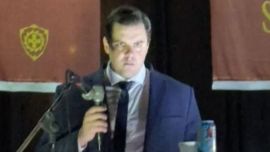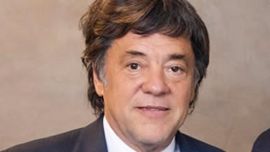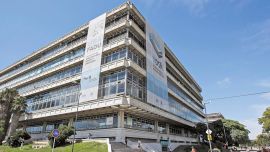For the first time since the resumption of trials addressing crimes against humanity in Argentina, a federal court has put five former military officers on trial for their alleged role in the infamous “death flights,” said to have departed from the Campo de Mayo military garrison.
According to prosecutors, the five individuals standing trial allegedly formed part of an Army structure that operated the so-called “vuelos de la muerte” that departed the Campo de Mayo military garrison, trips in which victims were thrown from planes or helicopters into the Río de la Plata.
Death flights were one of the many forms of extrajudicial and summary executions carried out by Argentina’s last military dictatorship (1976-1983) in order to disappear individuals they considered enemies of the state.
Today, hardly anyone in Argentina doubts that the flights took place, though to date the courts have only proven the existence of flights departing from the ex-ESMA Navy Mechanics School. That was done via cases involving the disappearances of members Mothers of the Plaza de Mayo human rights organisation, French nuns and another group of activists kidnapped in December 1977.
In contrast, the Army’s role in the practice has never been proven in court.
"The trial of those responsible in the Army for the flights is an important pending issue, as it was with the ESMA case," one of the case prosecutors, Marcelo García Berro, told the Times.
According to Federal Oral Court 2 of San Martín, the 601st Aviation Battalion, which had barracks at Campo de Mayo, provided the structure that oversaw the planes or helicopters that departed from the military garrison carrying anaesthetised people or murdered bodies.
The site was played home to one of the dictatorship’s main clandestine detention centres. An estimated 5,000 people passed through the doors of Campo de Mayo, few of whom survived.
Between 1975 and 1977, Luis del Valle Arce was the head of the 601st. On Monday, before the court, he denied any knowledge of the existence of the flights.
Arce is one of the members of the 601st accused of taking part in the crime, along with Delsis Ángel Malacalza, his second-in-command, and Eduardo Lance and Horacio Alberto Conditi, who were part of the battalion's highest-ranking staff. Next to his fellow officers, sat on the bench on Monday was Santiago Omar Riveros, a senior military chief who was in charge of the Campo de Mayo base.
"In this trial we are not judging the material authors, but those who occupied the structures on which the material authors depended," García Berro explained, detailing why charges had been brought against the accused.
The five men are accused of “organising, planning and carrying out” the flights.
The victims
During court hearings, which are being held by Zoom videoconference software due to restrictions put in place to tackle the coronavirus pandemic, the cases of four people kidnapped between 1976 and 1977 are being investigated.
The victims were taken to Campo de Mayo and never seen again. Later, their bodies were found on the Argentine coast and then buried in unmarked graves. Their bodies were identified only years later, thanks to the efforts of the world-renowned Argentine Forensic Anthropology Team (EAAF).
Rosa Eugenia Novillo Corvalán was abducted sometime between October and November 1976. Initially believed to have been a Campo de Mayo survivor, her body was later found off the coast near Magdalena, a town in Buenos Aires Province, on December 6, 1976. Her body had been shot three times prior to death.
For the investigators, Novillo Corvalán could have been killed either at one of the clandestine centres that operated inside Campo de Mayo or at the Aviation Battalion’s headquarters.
A military task force took Roberto Ramón Arancibia along with his wife María Eugenia Zago on May 11, 1977. Arancibia's body was found on February 18, 1978, on the coast of Las Toninas and was buried in the cemetery of General Lavalle, the same place where the founders of Madres de Plaza de Mayo kidnapped by an ESMA squadron, were also buried.
Juan Carlos Rosace and Adrián Enrique Accrescimbeni were students at the School of Technical Education "Ingeniero Emilio Mitre” in the district of San Martín, Buenos Aires Province.
Rosace was kidnapped at some point on November 4 and 5, 1976. His body was found on December 14, 1976 and analyses of the corpse determined that he had died from asphyxiation by immersion, proving he was alive at the time he was put on a plane.
Accrescimbeni was abducted one day after his friend, while he was standing at the school gate. His body was buried on December 22, 1976, in the cemetery of Magdalena. His body had traces of rope burns on his wrists and ankles.
The testimonies
"Different testimonies have provided evidence of the existence of death flights or ghost flights, but it took decades for the courts to judge them. That delay speaks to the Judiciary," Prosecutor Mercedes Soiza Relly, who is working alongside García Berro in the trial, told the Times.
Soiza Reilly served as a prosecutor in the third trial probing crimes at the ESMA, in which two Navy pilots were found guilty of their role for the death flights.
In addition to the survivors, some military personnel have come forward and confessed their involvement in the death flights.
Former Navy officer Adolfo Scilingo is perhaps the most famous, having detailed his involvement in the practice to journalist Horacio Verbitsky back in 1995. Another Army sergeant, Víctor Ibáñez, also talked about the existence of the trips, saying they were designed to get rid of the kidnapped victims.
A few years earlier, in 1991, then-lieutenant colonel Eduardo Francisco Stigliano initiated an administrative procedure with the Army, blaming them for nightmares that he said kept him awake at night. In a letter, he said that due-to-be-executed individuals were injected with a drug called Ketalar and that the bodies were wrapped in nylon and put into planes or helicopters that departed from the 601st Aviation Battalion.
Stigliano's claims today have now been verified by nearly 400 conscripts who testified as witnesses -- mostly thanks to the efforts of plaintiff attorney Pablo Llonto. The men, many of whom were carrying out their compulsory military service, detailed how trucks trucks and cars approached the airstrip. Some of them also reported seeing the containers with Ketalar on them.
"Many of the conscripts approached us thanks to a publicity campaign that would have to be repeated, considering that there are still many pilots, flight attendants and accomplices to be found," Llonto told the official news agency Télam, prior to the trial’s commencement.
About 100 conscripts will testify again during the trial, according to prosecutor Garcia Berro, with the hearings likely lasting at least a year. He is sure, however, that justice will be served.


























Comments